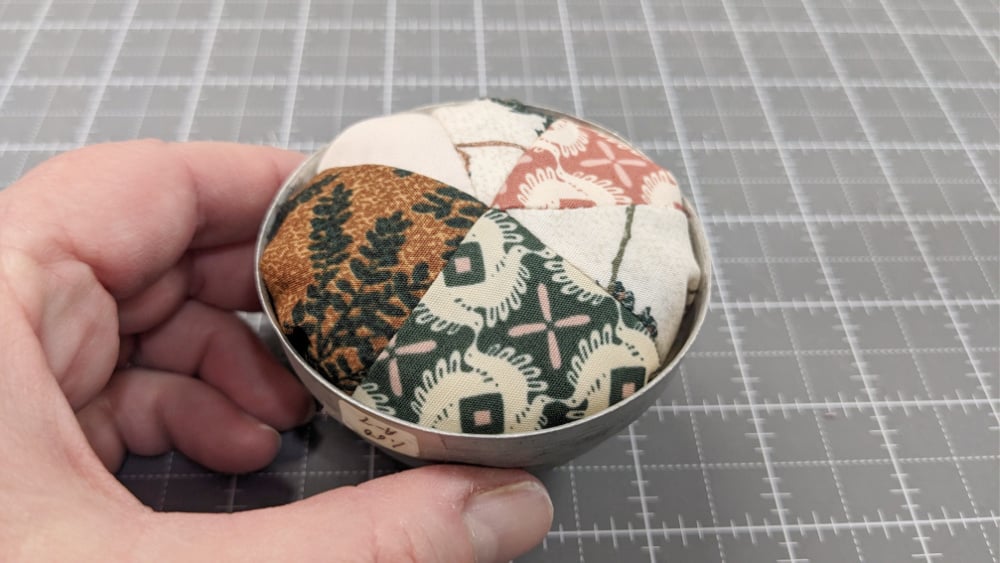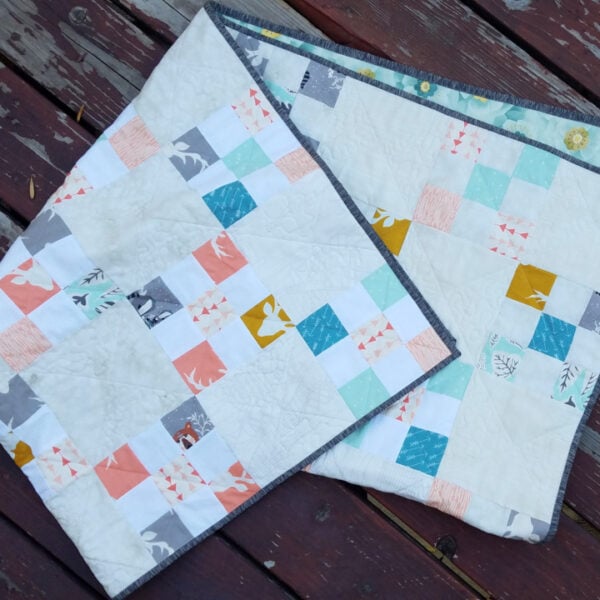Learn how to hand baste a quilt top. This is for prepping the quilt either for machine quilting or hand quilting. Hints and tips to help as well!
This past year I’ve been attending and actually was the president of the Salt Lake Modern Quilt Guild.
It’s been a lot of fun exploring new techniques and styles of quilting.
One of the things I did as the president was set up a quilt along for the year.
It was based on the GeeBend Quilts- trying to get to know the style and step out a little bit of our comfort zone.
Many of the members chose to even use only scissors, no rulers…etc.
I was not one, but I did step out and really just went for it.
When the top was complete, I gave thought to how I would like to finish it.
Was I going to use the long arm machine….or do something different?
After a little bit of exploring quilting styles for modern quilts, I thought that I would try out- hand quilting.
This is really quite out of my wheelhouse….but why not?!
I’ve done a little hand quilting on mini quilts and some baby-ish sized quilts, but nothing this size.
Today I thought I’d share my process of how I prepped the quilt for hand quilting. I’ll be sharing a few more on the process of hand quilting later as well.

How to Hand Baste a Quilt Top
Materials needed:
needle – sharp needle is best as it will be going through all the layers- top, batting, backing. You’ll want it just a little longer as well so it can go through those layers
thread – junky or weird colored thread is ok to use here. You’ll be removing these stitches, so it won’t matter.
tape
PREP:
Before starting this process, make sure your backing is cut to the right size. I typically have it around 4 inches larger than the quilt top. Just in case of shifting.
Also, you’ll want to have the batting cut to the right size as well- so you’re not fighting all the extra!
Instructions:
1- Press your quilt backing if you need. Get those wrinkles or creases out as well as the seam if your backing has been pieced.
2- Lay your backing WRONG SIDES UP on a hard surface. I used my hard floor.
3- Tape the backing down in the corners and maybe a few other spots to keep in place. You’ll want to use a tape that is strong enough to hold, but doesn’t leave residue on your floor. Painters tape will work fine. (I used duct tape– it’s a little over kill)

4- Lay your batting on top of the backing, centering it and smoothing it out so there are no creases or wrinkles
5- Lay your quilt top RIGHT SIDES UP and smooth it out as well

6- Using your needle and thread, start in the CENTER of the quilt and stitch out towards the edge.

Repeating this process of starting in the center and stitching outwards until the quilt top is covered in a grid style of quilting.
* Your needle will stab the under surface! Be aware that you may mark up the floor or the dining table. Be careful when you are stitching downward.
HINTS:
- The stitches can be big! They can be around 1 -1 1/2″
- I tie a knot on the one end so I don’t pull it out when stitching 🙂
- I did a grid style- but you can do another pattern that works well for you. You’ll just want to make sure the stitches are covering the whole quilt top
- Use a table or higher surface if the floor is too low
- Use a spoon or something to help lift the needle when stitching so you don’t wear your finger out trying to pry it through the layers


WANT TO REMEMBER THIS? SAVE THE HOW TO HAND BASTE A QUILT TOP TO YOUR FAVORITE DIY PINTEREST BOARD!

Do you have a suggestion or hint for us on Basting a quilt top?


Becky Jorgensen is the creative quilter behind Patchwork Posse, the Patchwork Planner and her online quilt group Patchworkers Plus. You can find her patterns in books, magazines, and her quilt membership. Gather your quilting supplies, organize your sewing space, explore the process of disappearing quilt blocks, or finish a free quilt pattern. I'll help you use what you have, finish what you start and make your quilting journey fun!
Follow me here: Facebook, Pinterest, YouTube






